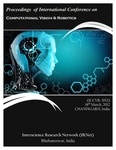

Published Date: 18-03-2012
Place of Conference: CHANDIGARH, INDIA
Publisher: Institute for Project Management Pvt. Ltd.
DownloadProceeding of International Conference on Computational Vision & Robotics
ISBN Back
Editors
Prof.Srikanta Patnaik Mentor, IRNet
About Conference
With an emerging and exponential growth of computational solutions to multifarious sociotechnical problems, the field of computer science is celebrated with radical innovations and advancements. The standing philosophy of such an enduring discipline is to duplicate the abilities of human vision by electronically perceiving and understanding an image. This image understanding can be seen as the disentangling of symbolic information from image data using models constructed with the aid of geometry, physics, statistics, and learning theory. As a technological discipline, computer vision seeks to apply its theories and models to the construction of computer vision systems. Examples of applications of computer vision include systems for, Controlling processes (e.g., an industrial robot), navigation (e.g. by an autonomous vehicle or mobile robot), detecting events (e.g., for visual surveillance or people counting), organizing information (e.g., for indexing databases of images and image sequences), modeling objects or environments (e.g., medical image analysis or topographical modeling), interaction (e.g., as the input to a device for computer-human interaction), automatic inspection, e.g. in manufacturing applications. The field is embodied with diversified with many application areas such as: medical computer vision or medical image processing. This area is characterized by the extraction of information from image data for the purpose of making a medical diagnosis of a patient. Generally, image data is in the form of microscopy images, X-ray images, angiography images, ultrasonic images, and tomography images. A second application area in computer vision is in industry, sometimes called machine vision, where information is extracted for the purpose of supporting a manufacturing process. Military applications are probably one of the largest areas for computer vision. The obvious examples are detection of enemy soldiers or vehicles and missile guidance. One of the newer application areas is autonomous vehicles, which include submersibles, land-based vehicles (small robots with wheels, cars or trucks), aerial vehicles, and unmanned aerial vehicles (UAV). The organization of a computer vision system is highly application dependent. Some systems are stand-alone applications which solve a specific measurement or detection problem, while others constitute a sub-system of a larger design which, for example, also contains sub-systems for control of mechanical actuators, planning, information databases, man-machine interfaces, etc. The specific implementation of a computer vision system also depends on if its functionality is pre-specified or if some part of it can be learned or modified during operation. The concept and creation of machines that could operate autonomously dates back to classical times, but research into the functionality and potential uses of robots did not grow substantially until the 20th century. Today, robotics is a rapidly growing field, as we continue to research, design, and build new robots that serve various practical purposes, whether domestically, commercially, or militarily. Many robots do jobs that are hazardous to people such as defusing bombs, exploring shipwrecks, and mines.

